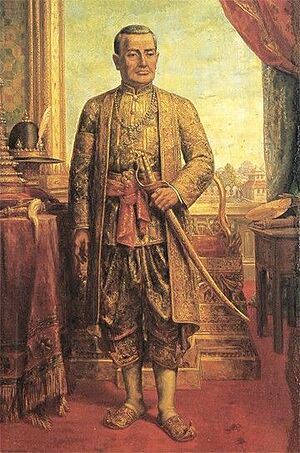Rama I facts for kids
Quick facts for kids
|
|
|---|---|
| King Rama I | |

Portrait at the Grand Palace, Bangkok
|
|
| King of Siam | |
| Reign | 6 April 1782 – 7 September 1809 |
| Coronation |
|
| Predecessor | Taksin (as King of Thonburi) |
| Successor | Phutthaloetla Naphalai (Rama II) |
| Viceroy |
|
| Deputy viceroy | Anurak Devesh |
| Born | 20 March 1737 Ayutthaya, Ayutthaya |
| Died | 7 September 1809 (aged 72) Bangkok, Siam |
| Burial | Wat Pho, Bangkok |
| Spouse |
|
| Issue | 21 sons and 21 daughters, including:
|
| House | Chakri dynasty |
| Father | Thongdi (later Somdet Phra Pathom Borom Maha Chanok) |
| Mother | Daoreung (Yok; later Phra Akkhara Chaya) |
| Religion | Theravada Buddhism |
| Seal |  |
Phra Bat Somdet Phra Phutthayotfa Chulalok Maharat (born Thongduang) was the first king of the Chakri dynasty in Siam (now Thailand). He is also known as Rama I. He founded the Rattanakosin Kingdom and made Bangkok its new capital.
Rama I became king in 1782 after King Taksin of Thonburi was removed from power. He was a very strong military leader. He helped reunite Siam after it was attacked by the Burmese. His reign brought back Siamese culture and a strong government after a difficult period. He also expanded Siam's influence across Southeast Asia.
Contents
About King Rama I's Name
King Rama I's name changed many times during his life. This was common for important people in old Siam. His birth name was Thongduang. Family names were not used in Siam back then.
When he worked for King Ekkathat of Ayutthaya, he was called Luang Yokkrabat. Later, under King Taksin, he received higher titles. These included Phraya Chakri and Somdet Chaophraya Maha Kasatsuek. This last title was very high, almost like royalty.
When he became king in 1782, he chose the name Ramathibodi. This name was also used by the founder of the Ayutthaya Kingdom. After he passed away, people called him Phaendin Ton, meaning "the first reign".
Later, his grandson, King Rama III, gave him a new name. This name was Phra Phutthayotfa Chulalok. It means "the Buddha on top of the sky and the crown of the worlds". This is the name used for him in Thai history books today.
Much later, King Vajiravudh (Rama VI) decided to use the name Rama for all kings of the Chakri dynasty. This made it easier for Westerners to remember their names. So, this king became Rama I. In 1982, he was given the special title Maharat, which means "The Great".
Early Life and Rise to Power
Growing Up in Ayutthaya
| Monarchs of the Chakri dynasty |
|
|---|---|
| Phra Buddha Yodfa Chulaloke (Rama I) |
|
| Phra Buddha Loetla Nabhalai (Rama II) |
|
| Nangklao (Rama III) |
|
| Mongkut (Rama IV) |
|
| Chulalongkorn (Rama V) |
|
| Vajiravudh (Rama VI) |
|
| Prajadhipok (Rama VII) |
|
| Ananda Mahidol (Rama VIII) |
|
| Bhumibol Adulyadej (Rama IX) |
|
| Vajiralongkorn (Rama X) |
|
Thongduang was born in 1737 in Ayutthaya. His father, Thongdi, was a noble who worked for the royal court. His family had roots from the Mon people and also some Chinese heritage.
As a young boy, Thongduang worked in the Royal Palace. There, he met Taksin, who would later become king. In 1757, as was the custom, he became a monk for a short time. In 1760, he married a woman named Nak, who later became Queen Amarindra. He then became a deputy governor in Ratchaburi Province.
Serving King Taksin
In 1767, the city of Ayutthaya was destroyed by Burmese invaders. King Taksin decided to create a new kingdom. Thongduang joined Taksin and became one of his most trusted generals.
Taksin quickly recaptured Ayutthaya and founded the Kingdom of Thonburi. He made Thonburi the new capital. Thongduang was given important roles in Taksin's government and army. He helped Taksin defeat other warlords and reunite Siam.
A Powerful Military Leader
Thongduang became a very successful military commander. He led Siamese troops in many wars against Burma. He also helped conquer lands in Cambodia and Laos.
His brother, Bunma (later Maha Sura Singhanat), often fought alongside him. Thongduang's military victories were very important for Siam. Because of his success, he received the highest noble title, Somdet Chao Phraya Maha Kasatsuek. This made him almost as powerful as a royal family member.
Becoming King

In 1781, while Thongduang was fighting in Cambodia, problems arose in Thonburi. King Taksin was removed from power. When Thongduang returned in 1782, he took control. He then became king himself, starting the Chakri dynasty. This dynasty still rules Thailand today.
King Rama I was crowned on April 6, 1782. He decided to move the capital to the east bank of the Chao Phraya River. This new city was named "Rattanakosin". It is now known as Bangkok. He chose this location because it was safer and he wanted to start fresh.
He also gave royal titles to his family members. His brother, Maha Sura Singhanat, became the "Front Palace". This was a special title for the viceroy and next in line to the throne. His nephew, Anurak Devesh, became the "Rear Palace".
King Rama I had 42 children. Ten of them were with Queen Amarindra. His son, Prince Isarasundhorn, later became King Buddha Loetla Nabhalai (Rama II).
Foreign Relations and Wars
Relations with Vietnam and Cambodia
King Rama I wanted to make Siam strong in the region. He helped Nguyễn Ánh, a Vietnamese leader, fight against the Tây Sơn brothers in Vietnam. However, their combined forces were defeated in the Battle of Rach Gam–Xoai Mut.
In Cambodia, Rama I also showed his influence. He brought the young Cambodian prince, Ang Eng, to Bangkok. He adopted him to teach him to be friendly towards Siam. He also appointed a Siamese-friendly regent to rule Cambodia.
Later, in 1794, Rama I reinstalled Ang Eng as king of Cambodia. Siam also took control of areas like Siemreap and Battambang. These areas were governed according to Cambodian traditions.
Wars with Burma
The most famous war during Rama I's reign was the Burmese–Siamese War (1785–1786). It is also known as the "Nine Armies War" because Burma attacked Siam with nine armies.
Burmese soldiers invaded northern Siam. Siamese forces, led by Prince Kawila, fought bravely. They delayed the Burmese until reinforcements arrived from Bangkok. King Rama I and his nephew, Anurak Devesh, led troops to the north. They successfully pushed back the Burmese.
In the south, the Burmese also attacked Phuket. Two brave sisters, Chan and Mook, gathered local people. They successfully defended Thalang (Phuket) against the invaders. Today, they are honored as heroines for their courage. Rama I gave them special titles for their actions.
Another monk named Phra Maha also led citizens to fight the Burmese in Songkhla. His efforts were successful, and Rama I recognized him. The Burmese king, Bodawpaya, eventually retreated. The next year, Bodawpaya attacked again, but was quickly defeated in the Tha Din Daeng campaign.
Death and Legacy
King Rama I passed away on September 7, 1809, after a short illness. His son, Prince Isarasundhorn, became the next king, known as Buddha Loetla Nabhalai or Rama II.
During Rama I's reign, Siam became very powerful. It successfully defended against Burmese attacks. Siam also gained control over Laos, Cambodia, and parts of Vietnam.
King Rama I also worked to revive Siamese culture. He encouraged new cultural works and built many temples and monuments. His actions laid a strong foundation for Siam's growth and expansion in the years that followed.
In Memoriam
- "Chakri Memorial Day" is a public holiday in Thailand. It is celebrated on April 6 to remember the founder of the Chakri dynasty.
- There is a statue of Rama I in front of the Memorial Bridge in Bangkok.
- The 500 baht banknote (Series 16, 2014) shows images of King Rama I. It also features the King Rama I monument, Wat Pho, and Phra Sumen Fort.
See also
 In Spanish: Rama I para niños
In Spanish: Rama I para niños
- Thai monarchs
- List of people with the most children





